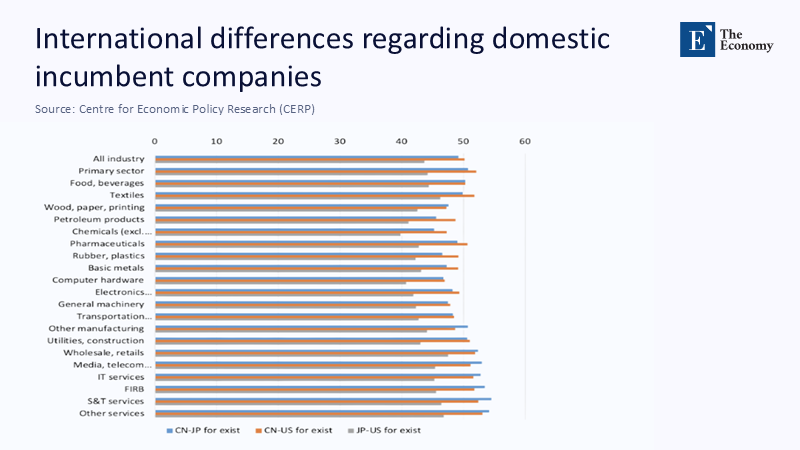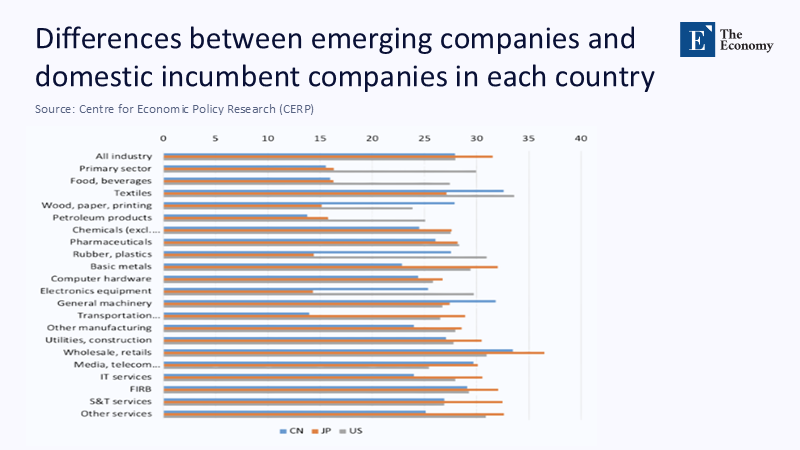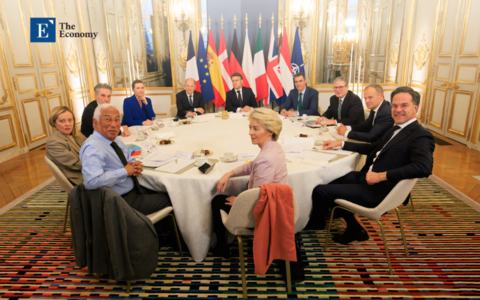Input
Changed
This article is based on ideas originally published by VoxEU – Centre for Economic Policy Research (CEPR) and has been independently rewritten and extended by The Economy editorial team. While inspired by the original analysis, the content presented here reflects a broader interpretation and additional commentary. The views expressed do not necessarily represent those of VoxEU or CEPR.
Japan plans to mobilize approximately ¥10 trillion (≈$65 billion) in public support for chips and AI by 2030. Yet, even that headline-grabbing sum barely dents the gap with the United States' multi-hundred-billion-dollar CHIPS-plus-IRA-plus-defense technology complex and China's state-guided semiconductor and AI war chest, which now includes a fresh $48 billion fund for chips alongside surging national R&D outlays. Meanwhile, Rapidus—Japan's flagship bet on 2-nanometre production—still requires approximately ¥5 trillion to establish mass manufacturing, but has secured only ¥1.72 trillion in subsidies to date, a reminder that even rich, technologically sophisticated allies are struggling to invest their way into the true technological frontier. Add the United States' successive waves of extraterritorial export controls (2022–2024, and again in late 2024/early 2025) that now rope in 24 classes of tools, high‑bandwidth memory chips, and 140 Chinese entities, and a harsher reality emerges: in this tech war, even friends get licences, not technology. For countries forced to choose between the two superpowers' spheres of influence, Japan's predicament is not a cautionary tale; it is the syllabus.

From "alignment" to "access bargaining": reframing the problem
The prevailing narrative says that middle powers must "choose" a side in the US–China technology confrontation, accept the costs of de-risking, and harvest the benefits of trusted-supply-chain preferential treatment. That diagnosis misses the central policy friction now revealed by Tokyo's experience: alignment no longer guarantees access. Japan has marched in step with Washington, joining the 2023 trilateral understanding among the United States, the Netherlands, and others on semiconductor export controls. This mirrors US measures, including licensing 23 categories of chipmaking tools and adopting a sweeping economic security law, as well as an AI bill in 2025, to structure diffusion and establish guardrails. Yet when it comes to frontier AI accelerators, state‑of‑the‑art lithography, or the newest high-bandwidth memory, the United States remains structurally unwilling (and legally constrained) to share at the speed or depth allies expect.
Reframing the argument from alignment to access is now crucial because the window for building domestic option value—capacity, talent, and interoperable standards that preserve policy choice—is narrowing and closing. As export controls widen, smuggling routes proliferate (over $1 billion in restricted Nvidia chips slipped into China between February and May 2025), and enforcement becomes both more aggressive and more porous, the premium on assured, contractual access for allies increases. If Japan, with its capital markets, deep engineering base, and alliance centrality, cannot secure a seat at the 2-nm and frontier-GPU table without caveats, what chance does any other middle power have without rewriting how alliances share technology?
The numbers don't add up: Japan's fiscal firepower versus US–China scale
The quantitative gap is not merely large—it is compounding. OECD data show that real R&D spending in the OECD area grew by 2.4% in 2023; however, China's R&D continues to surge faster, increasing its share of the global total. According to the US National Science Board's 2025 global R&D scorecard, global R&D expenditures reached approximately $3.1 trillion in 2022, in purchasing power parity (PPP) terms. By any reasonable extrapolation, China likely accounts for close to or above one-quarter of that total today, while Japan's R&D intensity has been essentially flat over the last decade. Even assuming Tokyo fully commits the touted ¥10 trillion by 2030 and catalyzes the ¥50 trillion in combined public–private investment its new economic security package targets, the aggregate would still trail the combined US CHIPS Act ($52 billion direct), Department of Defense innovation pipeline expansions, tax credits, and state subsidies, as well as China's centrally orchestrated funds and sprawling provincial incentives.
Methodologically, we can bound the gap by comparing cumulative policy‑directed tech industrial support through 2030 across the three blocs. For the United States, aggregating federal direct subsidies (CHIPS, DoD, DOE), selective state incentives, and IRA-driven advanced manufacturing credits yields a conservative estimate in the low hundreds of billions of dollars. For China, triangulating official announcements (e.g., the $48 billion semiconductor fund in 2024/25), past "Big Fund" cycles, and provincial matching yields a similar or higher envelope, particularly once accounting for non-transparent credit guidance and procurement. Japan's ¥10 trillion—ambitious domestically—amounts to a mid-single-digit percentage of either rival's total national tech effort. The implication is brutal: scale asymmetry makes "me-too" industrial policy mathematically incapable of closing access gaps. Only contractualized technology sharing, pooled procurement, and cross-border co-R&D with enforceable milestones can substitute for the missing scale.

The sharing problem: allies without reciprocity
Washington's export control architecture has hardened into a doctrine: deny China the ceiling, slow its climb, and accept collateral friction for allies as an unavoidable price. The October 2023 update and the 2024–2025 rounds expanded controls to 24 classes of tools and HBM chips, extended extraterritorial reach to non-US firms using US technology, and added 140 Chinese entities to the Entity List. Legal analyses from CSIS and others indicate that allies have limited autonomous authority to implement or deviate; they are expected to mirror, rather than modulate.
For Japan, this means its domestic firms are transformed into compliance agents, absorbing enforcement costs, delaying revenue from Chinese customers, and accepting that the most advanced US capabilities will be rationed—even for them—through export licences and black‑box thresholds. The Rapidus saga captures this asymmetry: the firm must import crucial intellectual property and toolchains, rely on US and European ecosystem partners, and hope that future US controls do not reclassify essential components out of reach. When friends obtain licenses, not technology, alignment creates political goodwill but not production certainty. For every other "left‑out" country, that is the pivotal lesson: ally status confers proximity, not parity.
What Japan teaches middle powers: build option value, not autarky
No country outside the United States and China will replicate the full stack—from leading‑edge logic to top‑tier GPUs, from EDA software to HBM packaging—at scale. Autarky is a fantasy. Option value is policy. That means three things. First, contracted access: Governments must negotiate explicit technology-sharing covenants with allies that tie export-control alignment to verifiable, time-bound access to specified nodes (e.g., "access to n+1 generations of HBM and AI accelerators, with licensing turnaround guarantees and price parity clauses"). Second, liquidity in capability: invest not to close the frontier, but to retain credible switching capacity—talent, pilot lines, interoperable standards, and sovereign compute for sensitive public workloads—that keeps bargaining power alive. Third, multilateral procurement pools: if Japan, South Korea, Taiwan, Australia, and select European economies jointly forward‑buy accelerators, tools, or secure cloud capacity, the bloc effect can shift commercial incentives for US firms and raise the political cost in Washington of withholding.

Japan's May 2025 AI bill demonstrates a nascent template: treating AI and semiconductors as economic-security assets governed by an integrated policy, rather than siloed industrial programs. Middle powers should go further, writing reciprocal-access clauses directly into their economic security legislation and alliance MOUs. In an era of weaponized interdependence, policy predictability is a traded good.
Anticipating the pushback—and why it falls short
Critique one: "The United States already shares more with its allies than China does; allies should accept frictions as the price of collective security." True—but the relevant benchmark is not generosity; it is sufficiency. If extraterritorial controls impose losses, there must be compensating, contracted gains. Otherwise, allied firms are squeezed between US ceilings and Chinese retaliation, as evidenced by repeated waves of Chinese countermeasures and Beijing's accelerated push for self-sufficiency.
Critique two: "Japan's problem is execution, not access—the state can simply spend more." The data contradict this. Even under optimistic uptake, Japan's ¥10 trillion program and the projected ¥50 trillion public–private pot remain a fraction of the US–China scale. The Rapidus financing gap is not just about money; it is also about timely access to IP, tools, and foundry customers willing to take a risk on a new entrant.
Critique three: "Smuggling proves controls are leaky; allies can get what they need through gray channels." That argument confuses Chinese demand‑side leakiness with supply-side certainty. Japan cannot base a national economic security strategy on gray‑market GPUs routed through Southeast Asia. Professional bureaucracies require de jure, not de facto, access. The $1 billion in smuggled Nvidia chips highlights enforcement limitations, not a sustainable procurement model for law-abiding allies.
A policy blueprint: alliance contracts, not alliance rhetoric
The policy move that transforms Japan's experience from lament to lesson is the contractualization of its expertise. Policymakers in education, research, and innovation portfolios should push for Alliance Technology Access Agreements (ATAAs) that bundle four elements: (1) granular, pre‑licensed access lists for chips, tools, and model weights; (2) pooled, forward‑priced procurement for accelerators and secure cloud compute usable by universities, startups, and public agencies across the bloc; (3) co‑R&D programmes with shared IP stacks, structured to prevent unilateral post‑hoc reclassification; and (4) dispute‑resolution and compensation mechanisms if export‑control expansions impair previously granted access.
To make this real, we can quantify the option value. Suppose an ATAA commits to delivering, at parity prices, 50,000 leading‑edge AI accelerators annually to a five‑country pool, with a three‑month licensing SLA and a five‑year rolling guarantee. At current market prices, that pool represents roughly $10–$15 billion in annual guaranteed capability—a scale meaningful enough to shift vendor and Washington calculus, but still an order of magnitude cheaper than each country attempting to recreate the frontier domestically. Add to that joint investments in sovereign, interoperable research clouds, where model weights can be shared within the alliance but ring‑fenced from adversaries, and you have a credible, financeable alternative to both autarky and dependence.
The Barometer Called Japan
Japan's ¥10 trillion plan, its ¥1.72 trillion-and-counting bet on Rapidus, its mirrored export controls, and its new AI legislation together form a single, flashing instrument panel. It tells us that in a bifurcating technological order, alignment without enforceable access is performative, subsidies without pooled scale are palliative, and rhetoric about "friend‑shoring" must be audited against actual delivery schedules, licensing queues, and price sheets. The world's remaining middle powers—especially those that educate the next generation of engineers, allocate scarce R&D funds, and write economic-security laws—should treat Japan's experience as their baseline scenario, not their worst-case scenario. The call to action is stark: write your access in ink, buy your option value now, and turn alliances into legally binding technology supply chains before the window for bargaining closes. Anything else is faith-based industrial policy in a world that has decisively moved on.
The original article was authored by Kazuyuki Motohashi, a Faculty Fellow at the Research Institute of Economy, Trade and Industry (RIETI). The English version of the article, titled "US-China high-tech friction and Japan’s response: Implications from a comparison of innovation processes," was published by CEPR on VoxEU.
References
Atlantic Council. (2025). Navigating the new reality of international AI policy.
Center for Strategic and International Studies (CSIS). (2023). Clues to the U.S.-Dutch-Japanese semiconductor export controls deal are hiding in plain sight.
Center for Strategic and International Studies (CSIS). (2024). Collateral damage: The domestic impact of US semiconductor export controls.
Center for Strategic and International Studies (CSIS). (2025). Understanding US allies' current legal authority to implement AI and semiconductor export controls.
Diplomat, The. (2025, July). Can Rapidus achieve Japan's semiconductor revival?
Global SMT & Packaging. (2024). Japan to provide additional $5.27 billion to Rapidus for domestic 2‑nm chip production.
Global Trade Alert. (2023). Japan: METI announces restrictions on chip equipment exports.
Hogan Lovells. (2023). Japan's new chip equipment export rules take effect.
Japan Cabinet Office / Government of Japan (via Winston & Strawn LLP). (2025). Comprehensive Economic Measures for Ensuring National Security and Sustainable Growth (summary blog, "Spotlight on Japan: Legal trends in the semiconductor industry").
Modern Diplomacy. (2025, May 10). US–China technology competition: A new Cold War threat to global stability.
National Science Board (NSB). (2025). Global R&D and international comparisons.
OECD. (2025, March). R&D spending growth slows in OECD, surges in China; government support for energy and defence R&D rises sharply.
Reuters. (2023, March 31). Japan restricts chipmaking equipment exports as it aligns with US China curbs.
Reuters. (2024, November 11). Japan unveils $65 billion plan to aid domestic chip industry.
US Federal Trade & Industry Analyses (WSJ, FT). (2024–2025). New US export controls on AI and semiconductors; 140 Chinese entities added to the Entity List; restrictions on 24 tools and HBM chips.
US International Center for Law & Economics. (2025). US export controls on AI and semiconductors.
US Studies Centre (2025). Developing a shared Australia–Japan agenda for economic security (noting Japan's 2025 AI bill).
War on the Rocks. (2025). Allied arsenal: Building strength through shared production.
Washington Post. (2025, July 12). Japan, after 101 tough days, learns a hard lesson about US alliance.
Financial Times. (2025, July 24). Nvidia AI chips worth $1bn smuggled to China after Trump export controls.
Wall Street Journal. (2024, December). Biden's farewell to China's tech sector: A new type of forbidden chip.






















Comment